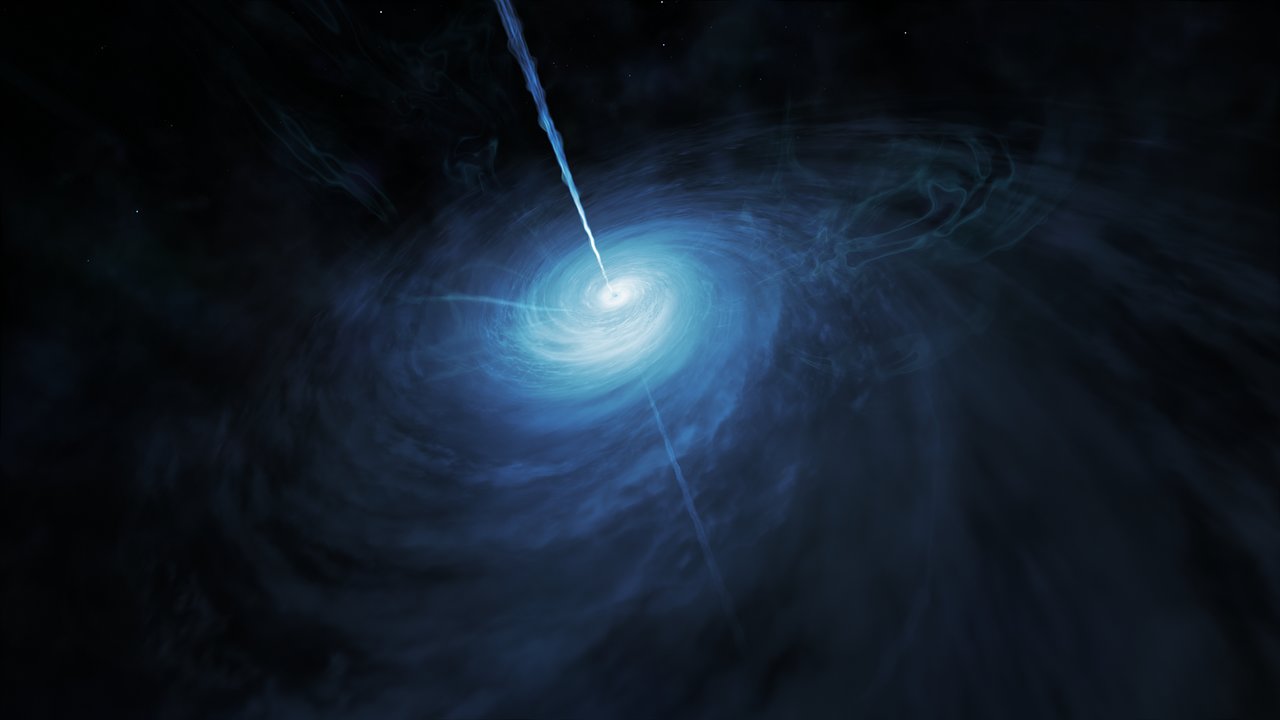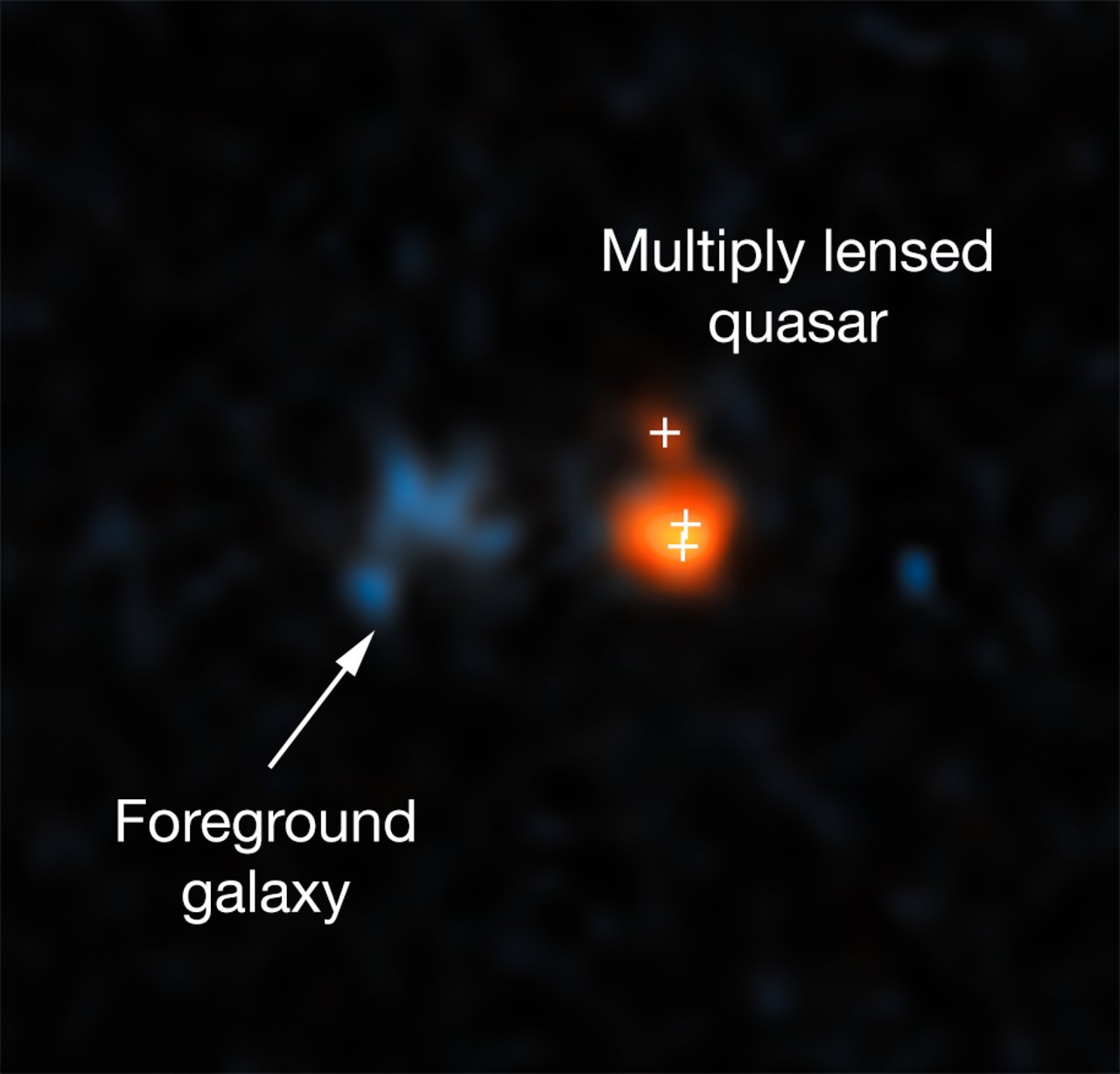The Brightest Quasar of the Early Universe Shines with the Light of 600 Trillion Suns
Scientists have discovered the energetic core of a distant galaxy that shatters the record for the brightest object in the early universe, blazing with the light equivalent to 600 trillion suns.
Researchers identified the object — a black-hole-powered object called a quasar, among the universe's brightest inhabitants — because of a chance alignment with a dim galaxy closer to Earth that magnified its light.
The quasar is 12.8 billion light-years away, and it shines at the heart of a forming galaxy during an early part of the universe's history called the epoch of reionization, when the first stars and galaxies began to burn away a haze of neutral hydrogen across the cosmos. Researchers announced its discovery on Jan. 9 at the American Astronomical Society's winter meeting in Seattle. [Watch: The Brightest Quasar of the Early Universe Explained]

"That's something we have been looking for for a long time," Xiaohui Fan, a researcher at the University of Arizona and lead author on the new work, said in a statement from the Hubble Space Telescope team. "We don't expect to find many quasars brighter than that in the whole observable universe!"
Several powerful ground-based telescopes and the Hubble Space Telescope pooled their observations of the object, now designated J043947.08+163415.7, to learn more about it. The quasar gets its brightness from a supermassive black hole: material from a disk of gas surrounding the black hole falls in, leading to blasts of energy at many different wavelengths, according to the statement. The quasar likely blazed when the universe was less than a billion years old, but some of its light is only now reaching Earth. According to the new observations, the black hole powering this quasar is several hundred million times the mass of the sun.
Despite its intense brightness, the distance to the quasar is so great that it wouldn't have been visible, if not for a lucky trick of positioning. Through a process called gravitational lensing, light from the quasar has bent around a galaxy in between the object and Earth, magnifying our view: the quasar appears three times as large and 50 times as bright as it would have otherwise, researchers said in the statement. And it was only observed at all because the intervening galaxy was dim enough to not drown out the light from the ultra-distant quasar.

Learning more about this quasar, which also appears to be producing 10,000 stars per year, can teach researchers more about this distant but pivotal time in history, when the first stars and galaxies were kindling and shaping the universe to what we know today. Even more telescopes are joining the search to try and discern more about the system.
Get the Space.com Newsletter
Breaking space news, the latest updates on rocket launches, skywatching events and more!
"This detection is a surprising and major discovery; for decades we thought that these lensed quasars in the early universe should be very common, but this is the first of its kind that we have found," Fabio Pacucci, a researcher at Yale University, a co-author on the work and lead author on a follow-up paper about the quasar, said in a statement from the Keck Observatory. "It gives us a clue on how to search for 'phantom quasars' — sources that are out there, but cannot be really detected yet.
"Our theoretical study predicts that we might be missing a substantial fraction of these 'phantom quasars,'" Paucci added. "If they are indeed numerous, it would revolutionize our idea of what happened right after the Big Bang, and even change our view of how these cosmic monsters grew up in mass."
The new work was detailed Jan. 9 in the Astrophysical Journal.
Email Sarah Lewin at slewin@space.com or follow her @SarahExplains. Follow us on Twitter @Spacedotcom and on Facebook. Original article on Space.com.
Join our Space Forums to keep talking space on the latest missions, night sky and more! And if you have a news tip, correction or comment, let us know at: community@space.com.

Sarah Lewin started writing for Space.com in June of 2015 as a Staff Writer and became Associate Editor in 2019 . Her work has been featured by Scientific American, IEEE Spectrum, Quanta Magazine, Wired, The Scientist, Science Friday and WGBH's Inside NOVA. Sarah has an MA from NYU's Science, Health and Environmental Reporting Program and an AB in mathematics from Brown University. When not writing, reading or thinking about space, Sarah enjoys musical theatre and mathematical papercraft. She is currently Assistant News Editor at Scientific American. You can follow her on Twitter @SarahExplains.









